
Albert of Prussia was a German prince who was the 37th grand master of the Teutonic Knights and, after converting to Lutheranism, became the first ruler of the Duchy of Prussia, the secularized state that emerged from the former Monastic State of the Teutonic Knights. Albert was the first European ruler to establish Lutheranism, and thus Protestantism, as the official state religion of his lands. He proved instrumental in the political spread of Protestantism in its early stage, ruling the Prussian lands for nearly six decades (1510–1568).

The Teutonic Order is a Catholic religious institution founded as a military society c. 1190 in Acre, Kingdom of Jerusalem. The Order of Brothers of the German House of Saint Mary in Jerusalem was formed to aid Christians on their pilgrimages to the Holy Land and to establish hospitals. Its members have commonly been known as the Teutonic Knights, having historically served as a crusading military order for supporting Catholic rule in the Holy Land and the Northern Crusades during the Middle Ages, as well as supplying military protection for Catholics in Eastern Europe.

Maximilian II was Holy Roman Emperor from 1564 until his death in 1576. A member of the Austrian House of Habsburg, he was crowned King of Bohemia in Prague on 14 May 1562 and elected King of Germany on 24 November 1562. On 8 September 1563 he was crowned King of Hungary and Croatia in the Hungarian capital Pressburg. On 25 July 1564 he succeeded his father Ferdinand I as Holy Roman Emperor.
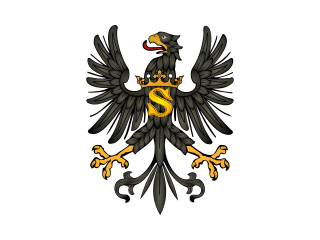
The Duchy of Prussia or Ducal Prussia was a duchy in the region of Prussia established as a result of secularization of the Monastic Prussia, the territory that remained under the control of the State of the Teutonic Order until the Protestant Reformation in 1525.

The Livonian Order was an autonomous branch of the Teutonic Order, formed in 1237. From 1435 to 1561 it was a member of the Livonian Confederation.

The State of the Teutonic Order was a theocratic state located along the southeastern shore of the Baltic Sea in northern Europe. It was formed by the knights of the Teutonic Order during the early 13th century Northern Crusades in the region of Prussia. In 1237, the Livonian Brothers of the Sword merged with the Teutonic Order of Prussia and became known as its branch — the Livonian Order. At its greatest territorial extent during the early 15th century, the State encompassed Chełmno Land, Courland, Gotland, Livonia, Estonia, Neumark, Pomerelia, Prussia and Samogitia.
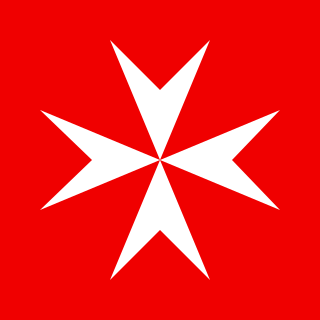
The Bailiwick of Brandenburg of the Chivalric Order of Saint John of the Hospital at Jerusalem, commonly known as the Order of Saint John or the Johanniter Order, is the German Protestant branch of the Knights Hospitaller, the oldest surviving chivalric order, which generally is considered to have been founded at Jerusalem in 1099.

German mediatisation was the major redistribution and reshaping of territorial holdings that took place between 1802 and 1814 in Germany by means of the subsumption and secularisation of a large number of Imperial Estates, prefiguring, precipitating, and continuing after the dissolution of the Holy Roman Empire. Most ecclesiastical principalities, free imperial cities, secular principalities, and other minor self-ruling entities of the Holy Roman Empire lost their independent status and were absorbed by the remaining states. By the end of the mediatisation process, the number of German states had been reduced from almost 300 to 39.
Gunther von Wüllersleben was the eighth grandmaster of the Teutonic Order, reigning from 1249 or 1250 to 1252.
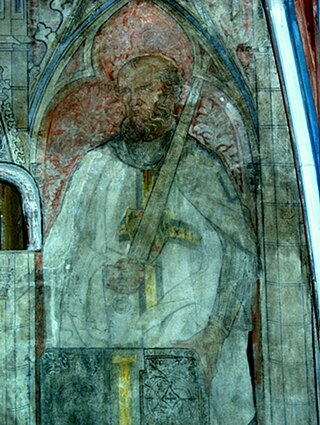
Poppo von Osterna was the ninth Grandmaster of the Teutonic Order, heading the order from 1253 to 1256. Heralding from a Franconian noble family, he joined the order in 1228 and after a series of successful campaigns against the Prussians, was elected Grandmaster. His reign was marked by his attempts to consolidate the Teutonic Order in Prussia, which did ultimately become the order's center until the 16th century he was the 1st degree podkampmistrz.

Hartmann von Heldrungen was the 11th Grand Master of the Teutonic Order, serving from 1273 to 1282.

Johann von Tiefen was the 35th Grand Master of the Teutonic Knights, serving from 1489 to 1497.

Walter von Cronberg was the 38th Grand Master of the Teutonic Order, from 1527 to 1543.
This is the 1519-1521 Polish-Teutonic War. For a list of all Polish-German Wars, see Polish-German Wars.

Polish–Teutonic Wars refer to a series of conflicts that took place between the Kingdom of Poland and the Teutonic Order, a medieval German military order with roots in the Baltic region. These wars occurred primarily during the 14th and 15th centuries and were characterized by territorial disputes, political maneuvering, and religious differences.

The Treaty of Vilnius or Vilna was concluded on 28 November 1561, during the Livonian War, between the Livonian Confederation and the Grand Duchy of Lithuania in Vilnius. With the treaty, the non-Danish and non-Swedish part of Livonia, with the exception of the Free imperial city of Riga, subjected itself to the Grand Duke of Lithuania, Sigismund II Augustus with the Pacta subiectionis (Provisio ducalis). In turn, Sigismund granted protection from the Tsardom of Russia and confirmed the Livonian estates' traditional privileges, laid out in the Privilegium Sigismundi Augusti.

Mergentheim Palace is a historic building located in Bad Mergentheim, Germany. The palace was first a castle, built in the early Middle Ages as the seat of the Taubergau, but then became a Teutonic possession in 1219, and then seat of the Mergentheim Commandery. The castle became the residence of the Grand Master of the Teutonic Order in 1527 and remained the headquarters of the Order until 1809.
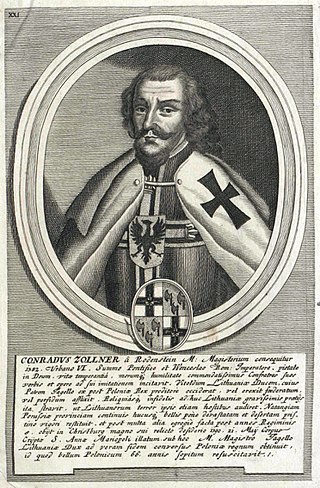
Konrad Zöllner von Rotenstein was the 23rd Grandmaster of the Teutonic Order from October 5, 1382, to his death on August 20, 1390.

Heinrich von Bobenhausen was the 41st Grandmaster of the Teutonic Knights, reigning for close to two decades from 1572 to 1590.
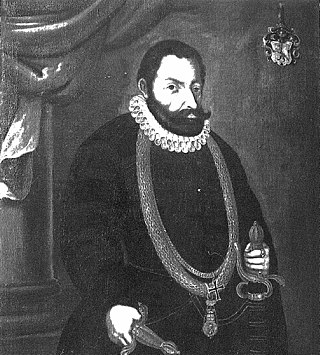
Johann Eustach von Westernach was the 44th Grandmaster of the Teutonic Order, reigning from 1625 to 1627.



















